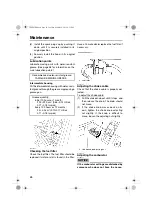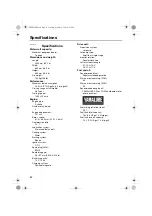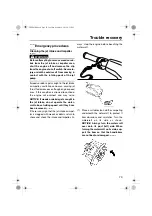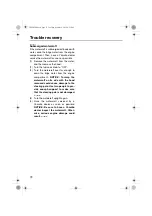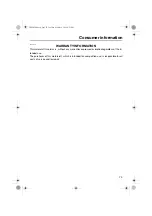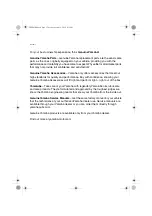
Maintenance
64
EJU3437B
Checking the spark plugs
WARNING
EWJ00351
Be careful not to damage the insulator
when removing or installing a spark plug.
A damaged insulator could allow sparks to
escape, which could result in a fire or ex-
plosion.
Remove and check the condition of the spark
plugs.
The condition of a spark plug can indicate
something about the condition of the engine.
For example, if the center electrode portion is
very white, this could indicate an intake air
leak or carburetion problem in that cylinder.
Do not attempt to diagnose any problems
yourself. Have a Yamaha dealer service the
watercraft.
To remove a spark plug:
(1) Remove the hood. (See page 26 for hood
removal and installation procedures.)
(2) Remove the spark plug cap.
(3) Remove the spark plug, and then check
the condition of the spark plug and the
spark plug gap. If the electrode portion is
significantly discolored, if electrode ero-
sion becomes excessive, if carbon and
other deposits are excessive, or if the
spark plug gap is not within the specified
range, replace the spark plug.
TIP:
When the engine is operating normally, the
color of the spark plug electrode portion will
be a medium-to-light tan.
To install a spark plug:
(1) Wipe off any dirt from the threads, insu-
lator, and gasket surface of the spark
plug.
(2) Install the spark plug, and then tighten it
to the specified torque.
TIP:
If a torque-wrench is not available when you
are reinstalling a spark plug, a good estimate
of the correct torque is 1/12 turn past finger-
tight. When you are installing a new spark
plug, a good estimate of the correct torque is
1/2 to 2/3 turn past finger-tight.
(3) Wipe off any water or dirt inside the
spark plug cap.
1
Insulator
2
Electrode
3
Spark plug gap
Specified spark plug:
B7HS
Spark plug gap:
0.6–0.7 mm (0.024–0.028 in)
Tightening torque:
Spark plug:
25 N·m (2.5 kgf·m, 18 lb·ft)
UF4D15E0.book Page 64 Tuesday, March 19, 2019 4:31 PM
















